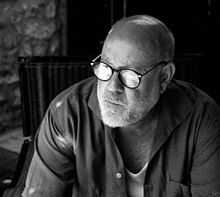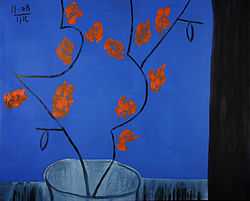Marcus Reichert
| Marcus Reichert | |
|---|---|
 Marcus Reichert in his studio, photograph by Edward Rozzo | |
| Born |
June 19, 1948 Bayshore, New York |
| Nationality | American |
| Known for | Painter, Poet, Film-maker |
Marcus Reichert (born June 19, 1948) is an American painter, poet, author, photographer, and film writer/director.
He was given his first exhibition of paintings at the age of twenty-one at the legendary Gotham Book Mart and Art Gallery, New York,[1] home to the Surrealists during WWII. In 1990, he was honored with a retrospective organised by the Hatton Gallery of the University of Newcastle upon Tyne which toured in various forms to Glasgow, London, Paris, and the United States. His Crucifixion paintings have been described by Richard Harries, the 41st Bishop of Oxford, as being among the most disturbing painted in the 20th Century,[2] while the American critic Donald Kuspit has written that both Picasso's and Bacon's pale in comparison.[3] The first neo-noir, Reichert's film Union City, which premiered at the 1980 Cannes Film Festival, was hailed by Lawrence O'Toole, film critic for Time magazine, as "an unqualified masterpiece."[4] His film works are held in the Archive of the Museum of Modern Art, New York.
Marcus Reichert is the author of three novels, including the cult classics Verdon Angster and Hoboken, and his writing is featured on the internet journals 3:AM Magazine and Newtopia Magazine. Published collections of his poems include "Lost Lake: Early Poems", "Confessions", "From the Balcony", and "The Defeated, The Exalted". "Marcus Reichert: The Human Edifice" by Mel Gooding, with 100 photographs by the artist in colour, is published by Artmedia Press, London and "Portrait of the Artist's Wife: Photographs 1966-2011" by Marcus Reichert is published by Ziggurat Books International, London.
Painting

oil and ink on canvas, 47 1/4 x 59 inches.
Marcus Reichert is an artist whose vision has never been deterred by social standards. Reichert started painting seriously at age 10, influenced by the work of Eduard von Gebhardt (1838-1925) – a German painter who preferred painting patients in local insane asylums. When Reichert wasn’t redefining von Gebhardt’s paintings in his family’s basement, he was out in the woods reading about Vincent van Gogh (1853-1890). From these two artists, Reichert formed the conclusion that, “… to be a painter one had to go beyond what was considered rational. One had to be oblivious to the distractions that others found meaningful” (Art Without Art, 13).
Reichert was born in 1948 in Bayshore, Long Island, grew up in rural Pennsylvania, and spent summers with his grandmother in Levittown, New Jersey. In the early 1960s, Reichert toured Paris and the South of France, where he currently resides and works. During the Vietnam War, Reichert attended the Rhode Island School of Design in the Independent Study program. He had grown up painting in the period during abstract expressionism, but was seeking something more literal.
There seemed to be an element of truthfulness in the obscurity of paintings by artists such as Alberto Giacometti and Francis Bacon, and Reichert embarked to find his own path in this trajectory of contemporary painting. Working out of New York and Bridgehampton in the 1970s, Reichert lived among painters Willem de Kooning, Larry Rivers, and Jack Youngerman. According to Reichert, “My determination was to take gestural painting into a new area of figuration which would be both spiritual and poetic, and without social or political connotations.”
Reichert exhibited his paintings for the first time when he was twenty-one at the Gotham Book Mart and Art Gallery in New York (1970). Since then, he has had several museum and gallery exhibitions in the United States and Europe. In that time, Reichert has also published three novels and created the film, “Union City,” which premiered at the 1980 Cannes Film Festival and is now held in the archive of the Museum of Modern Art, New York. Although he has also worked extensively in poetry, prose, and photography, he considers himself primarily a painter.
- - Adam Adelson, Director, Adelson Galleries Boston
Film
As a child, Marcus Reichert was first taken to the cinema by his grandmother who often escaped the summer heat of the New Jersey coast by indulging in an air-conditioned matinee. Most “serious” films of the period - the mid 1950’s - were still photographed in black and white and Reichert took particular joy in imagining the unfolding scenes in colour. His grandmother had a taste for “adult” romances, which obviously informs Reichert’s preoccupation in his own films and screenplays with psychologically distorted relationships.
oil and charcoal on linen, 76 x 74 inches.
Reichert’s earliest films, shot primarily in 8 mm, concentrate on the formal aspects of the human figure in an abstracted environment. This is particularly apparent in Silent Sonata which he co-directed with fellow-painter Akira Arita. The short films that follow - amputated scenes from scripts never realized in their entirety - have an atmosphere of anticipation about them, as if in pursuit of some barely glimpsed cinematic prey. The first neo-noir, Reichert's Union City was selected for the Directors' Fortnight at Cannes in 1980, and was hailed by Lawrence O'Toole, film critic for Time Magazine, as "an unqualified masterpiece." It has been in distribution ever since.
The film has been hugely influential, especially among younger filmmakers. As the actor Everett McGill (Quest For Fire, Brubaker, Heartbreak Ridge, Twin Peaks, Under Siege II), who played Larry Longacre in Union City, has said, "Before Twin Peaks there was Union City." Now considered a classic, the film was the centre-piece of the neo-noir festival held in 1997 by the American Museum of the Moving Image. Union City is in the Film Archive of the Museum of Modern Art, New York.
Filmography
Selected films by Marcus Reichert:
2004 SUNDAY EVENING, photography, design, and direction by Marcus Reichert for high definition surround sound music DVD; Lazy Curtis, Final Touch Productions Ltd., London (Executive Producer: Chris Smith)
1998 THE SEAWALL MURAL, design and direction by Marcus Reichert for public works fine art project; The Renaissance Project, Thanet Arts Development Office (Advisors: Christina McQuaid, Sam Thomas)
1991 PEOPLE, production design and direction for music video by Marcus Reichert; The Cutaways, Ragin’ Records, Iris Sound / Metropolis Film Studios, Philadelphia (Producer: David Ivory) - MTV Selection
1980 UNION CITY, written and directed by Marcus Reichert; The Tuxedo Company Inc., New York (Producers: Graham Belin, Monty Montgomery, Ron Mutz); owned by Marcus Reichert & Co. and The Museum of Modern Art, New York
1978 WINGS OF ASH (A Dramatization of the Life of Antonin Artaud), pilot for feature film, written and directed by Marcus Reichert; Silver Screen Productions Inc., New York and Mick Jagger, London (Producers: Monty Montgomery, Marcus Reichert)
1977 LE GRAND SILENCE, written, produced, and directed by Marcus Reichert; Silver Screen Productions Inc., New York
1968 SILENT SONATA, written and directed by Marcus Reichert and Akira Arita; Rhode Island School of Design
Photography
Background
STATEMENT ON PHOTOGRAPHIC IMAGERY BY MARCUS REICHERT
"In a world caught up in the pseudo-sophistication of a new barbarism, the power of the photographic image to transform thought becomes ever more compelling and, in many ways, ominous. There is always for the photographer the will to make sense of chaos - to make it legible - but the conjuring of an image for one’s own philosophical purposes, however calculating or innocent, necessarily constitutes a kind of aesthetic totalitarianism. I regard my photographic work very much as an objectification of the unreal: I perceive an idealised world, in formal and atmospheric terms, that does not exist, at least not until the photograph is taken. When I compose a picture, attempting to remain faithful to my instinct for abstraction, I seek a simplification and hence a purification of what I see. Given the staggering abundance of literally everything - visual detritus strewn everywhere - my job is to isolate and distil whatever peculiar beauty I might find lurking in the miasma. In the camera, when one fastens with determined intent upon another human being, an unfamiliar interior, a darkened building, one can impose all sorts of ulterior meanings on that presence. This proposition - of evoking a new reality - awakens an almost ruthless determination in me. Ultimately, the subject collaborates in the act. Nevertheless, one imposes an egocentric idea of beauty on the subject, and thereby on the eye of the beholder."
Reichert's photographs are represented by Michael Hoppen Contemporary (website), London.
Monographs (photography)
- Gooding, Mel (2003). Reichert: The Human Edifice. London: Artmedia Press. ISBN 190288907X. 100 colour photographs from 30 years of the artist's work.
- Reichert, Marcus (2011). Portrait of the Artist's Wife: Photographs 1966/2011. London: Ziggurat Books. ISBN 9780956657947.
- Chan, Amos; Harry, Deborah; Reichert, Marcus (2012). "Behind Union City: the Making of an Independent Film". London: Ziggurat Books International. ISBN 9780956657961.
Writing
oil, ink, and charcoal on canvas
59 x 47 1/4 inches.
Books about or by Marcus Reichert:
- Rare early editions of Verdon Angster, Hoboken", and The Miracle of Fontana’s Monkey are available on-line from The Book Depository and Central Books, London.
- Marcus Reichert: Selected Works 1958-1989 is available on-line from the Book Depository and Central Books, London.
- Displaced Person: Poetry, Pornography & Politics by Marcus Reichert is published by Ziggurat Books, London and is available on-line from The Book Depository and Central Books, London. The book features selected writing from 1970 to 2005, including Reichert's controversial political articles for the internet, confessional poetry, and excerpts from his three novels. ISBN 9781900439046.
- Art & Ego: Marcus Reichert in Conversation with Edward Rozzo is published by Ziggurat Books, London and is available on-line from the Book Depository and Central Books, London. ISBN 9780954665654.
- Les Fleurs: The Studies, by Marcus Reichert, introduction by Adam Adelson (2013) is published by Ziggurat Books International and available from Adelson Galleries Boston and on-line from The Book Depository and Central Books, London. ISBN 9780957391123.
References
- ↑ Exhibition: My Favorite Pictures: Works by Marcus Reichert, Gotham Book Mart and Art Gallery, New York, May 1970.
- ↑ Harries, Richard (Bishop of Oxford): Art and the Beauty of God: A Christian Understanding, 1993, Mowbray, London, Page 140, illustration Page 87. ISBN 0-264-67306-9
- ↑ Kuspit, Donald: 'The Crucifixion according to Marcus Reichert', Modern Painters, Vol.11 No.4, Pages 94-95, Fine Art Journals Ltd., London, Winter Issue, 1998.
- ↑ O’Toole, Lawrence: 'The curtain goes up at Cannes', MacLean’s Magazine, Toronto, 26 May 1980.
External links
- www.marcusreichert.com Official Marcus Reichert website, features galleries and additional information.
- IMDb entry on Marcus Reichert
- Interview with Marcus Reichert, by Richard Marshall, 3:AM Magazine
- Press release for Displaced Person and Union City on the Official Blondie Web Site, includes images and additional information.
- "Marcus Reichert". Adelson Galleries Boston, Marcus Reichert's paintings and biography.
|